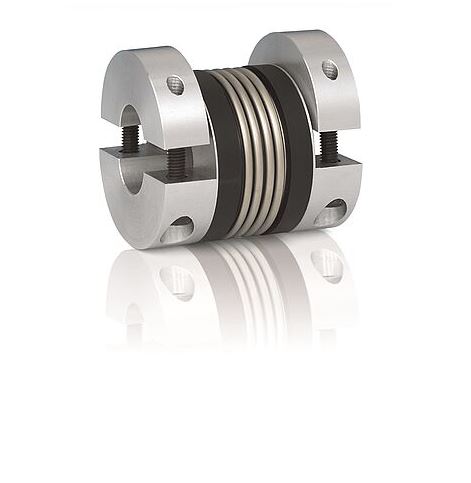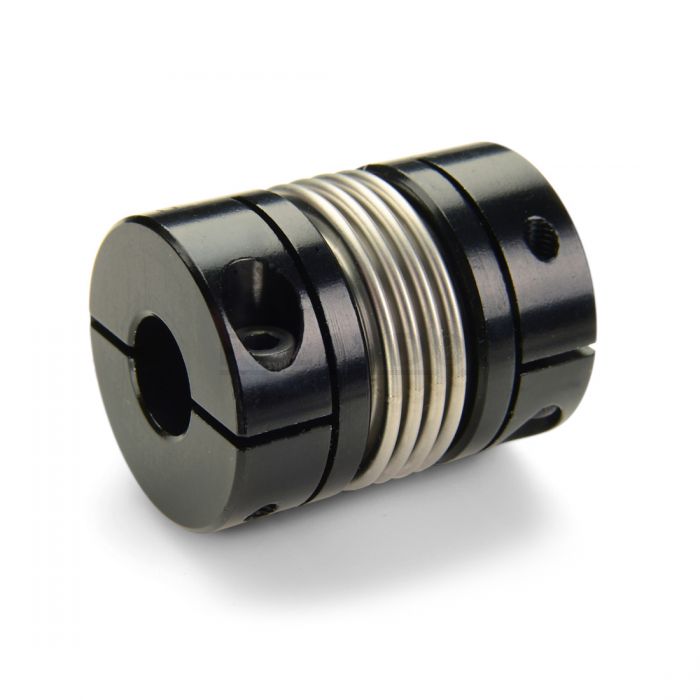Product Description
GRC Aluminum alloy bellows clamping coupling
Description of GRC Aluminum alloy bellows clamping coupling
>The material is aluminum alloy, and the middle bellows is made of stainless steel with excellent corrosion resistance
>Laser welding is used between bellows and shaft sleeve, with zero rotation clearance, suitable for CHINAMFG and reverse rotation
>Bellows structure can effectively compensate radial, angular and axial deviation
>Designed for servo motor stepper motor
>Fastening method of clamping screw
Dimensions of GRC Aluminum alloy bellows clamping coupling
| model parameter | common bore diameter d1,d2 | ΦD | L | L1 | L2 | L3 | N | F | M | tightening screw torque (N.M) |
| GRC-16×27 | 4,5,6,6.35,7,8 | 16 | 27 | 7.5 | 2 | 8 | 13.5 | 3 | M2.5 | 1 |
| GRC-20×32 | 5,6,6.35,7,8,9,9.525,10 | 20 | 32 | 7.2 | 2.8 | 12 | 18 | 3.5 | M3 | 1.5 |
| GRC-22.5×34 | 5,6,6.35,7,8,9,9.525,10,11,12 | 22.5 | 34 | 8.05 | 2.8 | 12.3 | 20.2 | 4.5 | M3 | 1.5 |
| GRC-25×37 | 6,6.35,7,8,9,9,9.525,10,12 | 25 | 37 | 9.5 | 3 | 12 | 20.2 | 4.5 | M3 | 1.5 |
| GRC-32×42 | 8,9,9.525,10,11,12,12.7,14,15 | 32 | 42 | 8 | 4 | 18 | 27.2 | 5.5 | M4 | 2.5 |
| GRC-40×55 | 8,9,9.525,10,11,12,12.7,14,15,16,17,18,19,20 | 40 | 55 | 11.5 | 6 | 20 | 34.5 | 6.5 | M5 | 7 |
| GRC-55×72 | 10,11,12,12.7,14,15,16,17,18,19,20,22,24,25 | 55 | 72 | 16.5 | 6 | 27 | 51.9 | 10 | M6 | 12 |
| GRC-65×81 | 10,11,12,12.7,14,15,16,17,18,19,20,22,24,25,28,30,32,35,38 | 65 | 81 | 19.5 | 7 | 28 | 60.5 | 10.5 | M6 | 12 |
| model parameter | Rated torque (N.M)* |
allowable eccentricity (mm)* |
allowable deflection angle (°)* |
allowable axial deviation (mm)* |
maximum speed rpm |
static torsional stiffness (N.M/rad) |
moment of inertia (Kg.M2) |
Material of shaft sleeve | surface treatment | weight (g) |
| GRC-16×27 | 0.8 | 0.1 | 1.5 | + 0.4 -1.2 | 9400 | 150 | 8.0×10-7 | High strength aluminum alloy | Anodizing treatment | 8 |
| GRC-20×32 | 1.5 | 0.15 | 2 | + 0.6 -1.8 | 7600 | 220 | 2.2×10-6 | 13 | ||
| GRC-22.5×34 | 1.8 | 0.15 | 2 | + 0.6 -1.8 | 6000 | 300 | 6.5×10-6 | 22 | ||
| GRC-25×37 | 2.0 | 0.15 | 2 | + 0.8 -1.8 | 6100 | 330 | 6.9×10-6 | 30 | ||
| GRC-32×42 | 2.5 | 0.2 | 2 | + 0.8 -2.5 | 4700 | 490 | 2.1×10-5 | 53 | ||
| GRC-40×55 | 6.4 | 0.2 | 2 | + 0.8 -2.5 | 4200 | 530 | 2.3×10-5 | 97 | ||
| GRC-55×72 | 12 | 0.2 | 2 | + 0.8 -2.5 | 3900 | 860 | 3.7×10-5 | 200 | ||
| GRC-65×81 | 18 | 0.2 | 2 | + 0.7 -2.5 | 3500 | 900 | 3.6×10-5 | 380 |
/* January 22, 2571 19:08:37 */!function(){function s(e,r){var a,o={};try{e&&e.split(“,”).forEach(function(e,t){e&&(a=e.match(/(.*?):(.*)$/))&&1

What are the Maintenance Requirements for Bellows Couplings to Ensure Reliable Performance?
Proper maintenance of bellows couplings is essential to ensure their reliable performance and extend their service life. Here are some maintenance requirements and practices for bellows couplings:
- Regular Inspection: Perform routine inspections of the bellows coupling to check for any signs of wear, damage, or misalignment. Look for cracks, tears, or deformation in the bellows element, as these issues can lead to coupling failure.
- Lubrication: In most cases, bellows couplings do not require lubrication. However, some specific applications or coupling designs may benefit from periodic lubrication of the shafts. Always follow the manufacturer’s guidelines regarding lubrication, as using the wrong type of lubricant can damage the coupling.
- Keep the Coupling Clean: Ensure that the bellows coupling and its surroundings are clean and free from debris. Dirt, dust, and foreign particles can accelerate wear and reduce the coupling’s performance.
- Avoid Overloading: Do not exceed the maximum torque and speed limits specified by the manufacturer. Overloading the coupling can cause premature failure and compromise the system’s performance.
- Address Misalignment and Shaft Movement: If misalignment or shaft movement occurs during operation, identify and correct the root cause promptly. Excessive misalignment or axial motion can put extra stress on the bellows and lead to premature failure.
- Inspect Fasteners: Check and tighten the fasteners, such as set screws or clamping screws, that secure the coupling to the shafts. Loose fasteners can cause the coupling to slip or shift, affecting its performance.
- Replace Damaged Couplings: If any signs of damage or wear are detected during inspection, replace the bellows coupling with a new one. Continuing to use a damaged coupling can result in catastrophic failure and potential damage to connected machinery.
- Follow Manufacturer’s Guidelines: Always follow the maintenance instructions provided by the coupling manufacturer. They may have specific recommendations for inspection intervals, cleaning methods, and other maintenance practices.
By following these maintenance practices, you can ensure that your bellows couplings remain in good condition and deliver reliable performance throughout their operational life. Regular inspections and proactive maintenance help identify potential issues early, allowing you to take corrective actions before they escalate into more significant problems.

Are Bellows Couplings Suitable for Use in Corrosive or Harsh Environments?
Bellows couplings can be suitable for use in corrosive or harsh environments, depending on the material they are made from and their design. The choice of material is a crucial factor in determining the coupling’s resistance to corrosion and its ability to withstand harsh conditions.
Common materials used in manufacturing bellows couplings that offer good resistance to corrosion include stainless steel and other high-grade alloys. Stainless steel is known for its excellent corrosion resistance, making it well-suited for applications in harsh or corrosive environments.
In some cases, bellows couplings can be coated or treated with specialized coatings to further enhance their resistance to corrosion. These coatings can provide an additional layer of protection, allowing the coupling to perform effectively even in highly aggressive surroundings.
It’s essential to consider the specific environmental conditions and the type of corrosive agents present when selecting a bellows coupling for use in such environments. Proper material selection and the appropriate protective measures can ensure the longevity and reliability of the coupling under challenging conditions.
Additionally, it is essential to consult with coupling manufacturers or experts to identify the most suitable coupling material and design for the particular corrosive or harsh environment in question. Customized bellows couplings may be available to meet specific requirements, providing further versatility in addressing the challenges posed by corrosive or harsh conditions.

What are the Key Design Considerations when using Bellows Couplings for Precision Applications?
When using bellows couplings in precision applications, several key design considerations must be taken into account to ensure optimal performance and accuracy. These considerations include:
- Torsional Stiffness: In precision applications, maintaining torsional stiffness is crucial to minimize angular deflection and maintain accurate positioning. Choose bellows couplings with high torsional stiffness to ensure precise torque transmission.
- Backlash-Free Design: Backlash can introduce positioning errors in precision systems. Select bellows couplings with minimal or zero backlash to maintain accurate motion control.
- Radial Runout: Ensure that the bellows coupling has low radial runout to prevent eccentricity and vibration during rotation, contributing to smoother operation.
- Material Selection: Choose materials with excellent fatigue resistance and high strength to withstand continuous operation and provide long-lasting performance.
- Misalignment Compensation: Evaluate the required misalignment compensation for the specific application. Bellows couplings should be capable of accommodating both angular and axial misalignments without sacrificing precision.
- Compact Size: For applications with limited space, consider compact bellows couplings that provide high torque capacity in a small form factor.
- Temperature and Corrosion Resistance: If the application involves extreme temperatures or harsh environments, opt for bellows couplings made from materials that offer temperature and corrosion resistance.
- Vibration Damping: Bellows couplings with good vibration damping properties help reduce resonance and maintain system stability during high-speed operations.
- Electrical Isolation: In precision applications with sensitive electronics, consider bellows couplings that provide electrical isolation to prevent electrical currents from passing between shafts.
- Customization: Some precision applications may require tailored solutions. Collaborate with coupling manufacturers to explore custom designs that meet specific requirements.
By carefully considering these design aspects, engineers can select the appropriate bellows coupling that aligns with the precision application’s needs, ensuring accurate motion control, reliability, and enhanced performance.


editor by CX 2024-03-09
